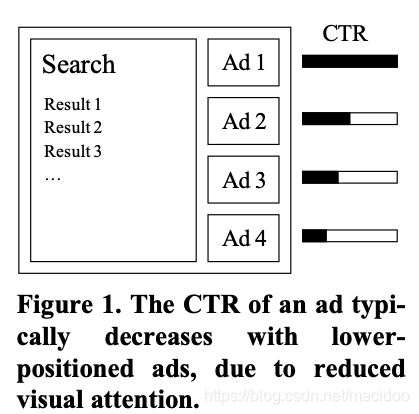文章目录
太长不看版
Predicting Clicks: Estimating the Click-Through Rate for New Ads
论文主要思想:提出了一种预测新广告CTR的办法。
论文使用方法:提出了新的特征,使用逻辑回归 (logistic regression) 模型训练,使用模型预测CTR的 KL散度和均方差(MSE)来验证实验效果。
上述新的特征包括以下四个方面:
- CTR相关特征:
- Term CTR:包含相同关键词的其他广告的CTR
- Related Term CTR:包含相近关键词的其他广告的CTR
- 新广告本身特征
- Appeareanc:广告本身是否美观
- Attention Capture:广告是否有吸引力
- Reputation:广告主的知名度
- Landing Page Quality:登陆页的质量(我理解为广告引流页的质量)
- Relevance:广告和用户检索词 (search query)的相关性
- 广告指向的明确性:
- 作者认为指向越明确的广告CTR越高
- 外部特征:
- 关键词在网络上的词频
- 关键词在搜索引擎上的词频
Motivation
为什么要预测广告CTR?
因为广告主爸爸给钱。例如谷歌雅虎等广告主爸爸会按照点击结算方式(cost-per-click CPC)给钱,即用户每点一次广告,爸爸就要给一次钱。
卑微的广告展示方怎么才能挣到更多钱呢,他们可以用这个公式计算收入的期望值:
E a d [ r e v e n u e ] = p a d ( c l i c k ) ∗ C P C a d E_{ad}[revenue] = p_{ad}(click)*CPC_{ad} Ead[revenue]=pad(click)∗CPCad
其中 C P C a d CPC_{ad} CPCad是广告爸爸对一次点击的出价, p a d ( c l i c k ) p_{ad}(click) pad(click)是对该条广告的点击率预测(CTR)。出价是爸爸定的,但是把CTR高的广告往前放,卑微的广告展示方就可以挣到更多钱。
这里论文作者做了一个简单的解释,在广告展示界面上,排在越靠前的广告被用户注意到的可能性越大(这也导致CTR越大)。因此,在决定广告出现顺序的时候,需要精确预估每条广告的CTR,然后把CTR高的排前面。
在预估每条广告的CTR时,作者先排除了广告出现位置的影响,否则就会死锁:广告CTR越高越往前放,越往前放进而导致CTR越高,就不好计算了。

为什么要预测新广告的CTR?
因为广告主爸爸每天发来的新广告特别多,由于缺少历史点击数据,无法准确预估其CTR,卑微的广告展示方需要尽快确定新广告质量,以决定投放顺序,挣更多钱。所以作者针对这个问题,提出了一系列的新特征来拟合新广告的质量。
广告搜索框架
广告的点击率(CTR)由两个因素决定:
- 用户看到它的可能性:由广告出现的位置(pos)决定
- 用户看到它之后点击它的可能性:由它本身质量决定
因此,广告的点击率可以公式化为:
p ( c l i c k ∣ a d , p o s ) = p ( c l i c k ∣ a d , p o s , s e e n ) ∗ p ( s e e n ∣ a d , p o s ) p(click|ad, pos) = p(click|ad,pos,seen)*p(seen|ad,pos) p(click∣ad,pos)=p(click∣ad,pos,seen)∗p(seen∣ad,pos)
为此,论文作者做了简化假设,假设广告被用户看到的概率只与出现位置有关(与广告本身质量无关);用户看见广告后,点击它的概率只与广告质量有关(与广告出现位置无关)。这里有点绕口,其实就是假定了上述两个因素互相独立。于是,公式可以简化为:
p ( c l i c k ∣ a d , p o s ) = p








 最低0.47元/天 解锁文章
最低0.47元/天 解锁文章














 10万+
10万+











 被折叠的 条评论
为什么被折叠?
被折叠的 条评论
为什么被折叠?








